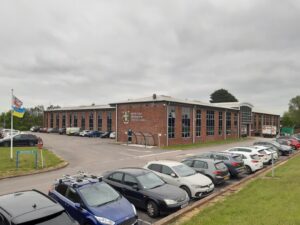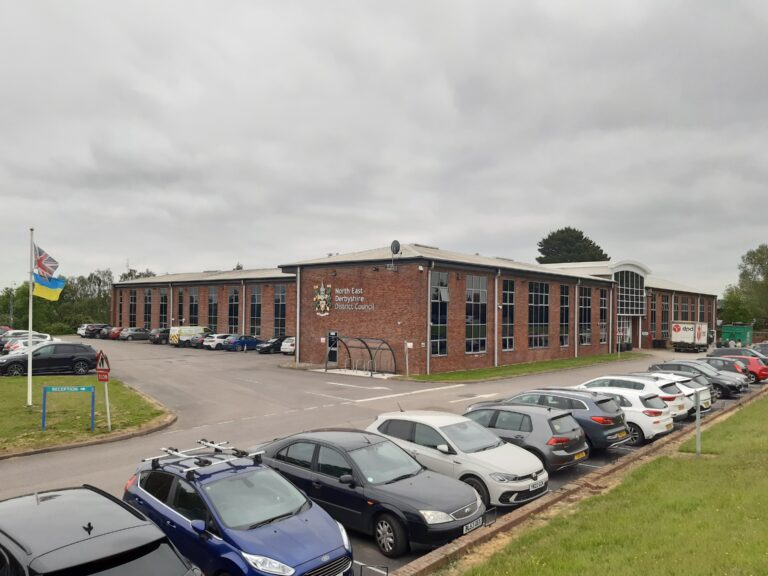
North East Derbyshire District Council has voted by a majority in favour of a proposed new ‘One Derbyshire, Two Councils’ model for the county with just two north and south councils under Government plans to scrap county, district and borough councils.
The Labour-controlled council held an Extraordinary Meeting on November 3 where it debated the Labour Government’s Local Government Reorganisation White Paper plans to set up single, unitary authorities across England with an elected mayor in counties by replacing county, district and borough councils in two-tier authority areas like Derbyshire.
Councillors voted with a 64per cent majority to propose a ‘One Derbyshire, Two Councils’ model that would have different parishes from Amber Valley joining each of the north and south councils and would give a northern population of 567,000 across 2,068sq km and a southern population of 511,000 across 560sq km.
Council Leader, Cllr Nigel Barker, said: “The amount of work that has gone in over the last year has been phenomenal. Honestly, it’s been massive and it has taken time and effort and it’s been an epic undertaking and we are pleased to see it come to some sort of conclusion. To get this far and putting this document together has been massive.
“When we first heard about this from the Government I was disappointed and angry but I did think it was better to be in the process to get the best outcome for the people of Derbyshire.”
Cllr Barker added that Local Government cannot continue in its current form after the financial struggles of local authorities have been well-documented but society has to keep providing the services people need with a chance to focus on health and well-being equalities with more prevention instead of reacting to crises.
The council voted 64per cent in favour, with 33per cent against, and three per cent abstaining, of a model known as Option A1 out of a possible four being considered by all the county’s eight borough and district councils and Derby City Council who are all in favour of a ‘One Derbyshire, Two Councils’ format before they vote on their preferred variation out of four options.
Derbyshire County Council is developing its own proposal also based on just two north and south councils with its own specific details which is to be submitted to the Government separately.
North East Derbyshire District Council’s preferred Option A1 would see NE Derbyshire, Chesterfield, Bolsover, High Peak, Derbyshire Dales and part of the Amber Valley in one northern unitary council, and Derby City, Erewash, South Derbyshire, and part of Amber Valley in the southern unitary council.
Parishes in the northern council would include: Aldercar and Langley Mill, Alderwasley, Alfreton, Ashleyhay, Belper, Codnor, Crich, Denby, Dethick, Lea and Holloway, Hazelwood, Heanor and Loscoe, Idridgehay and Alton, Ironville, Pentrich, Ripley, Shipley, Pottle and Postern, Somercotes, South Wingfield and Swanwick.
Parishes in the southern council would include: Duffield, Holbrook, Horsley, Woodhouse, Kedleston, Kirk Langley, Mappworth, Mapperley, Quarndon, Rabensdale Park, Smalley, Turditch, Weston Underwood, and Windley.
Green Party Derbyshire County Cllr Rachael Hatchett has said that any plans to split the Amber Valley is not something reflected by the feelings of those in this districts but Amber Valley Borough Council is yet to propose its preferred option under the ‘One Derbyshire, Two Councils’ plans.
Other options being considered by the county’s other city, district and borough councils include Option A which would see Amber Valley in the northern council and would see a northern population of 584,000, and the southern council area would have a population of 494,000.
Option B would place Amber Valley in the southern council and would see a northern population of 456,000, and the southern council area would have a population of 622,000.
And Option B1 would see part of Amber Valley in the northern council and part of Amber Valley in the southern council with Amber Valley parishes split with some in the north and some in the south, with a northern population of 539,000 and a southern population of 538,000.
North East Derbyshire District Council’s Managing Director Lee Hickin told the meeting he believes LGR with ‘One Derbyshire, Two Councils’ will secure long-term financial resilience and strengthen the area’s collective voice regionally and nationally with better links to the East Midlands Combined County Authority.
He added: “A north-south split strikes the right balance. It keeps the population size manageable but preserves local identity and makes sure services are delivered to communities creating a single point of contact in each area making it easier to get things done and be accountable.”
Mr Hickin revealed that over 7,000 people had taken part in a public consultation concerning the city, district and borough councils’ proposals and that 43 per cent of respondents had agreed with plans to reduce the number of councils in England while 39per cent agreed with the plans to replace the ten existing councils in Derbyshire with two councils while 45 per cent disagreed.
He conceded that he does not see LGR as a ‘silver bullet’ that will fix everything, particularly funding issues for Adult Social Care, Children’s Services and SEND currently overseen by Derbyshire County Council, but he says doing nothing and staying the same is not going to work.
But Mr Hickin added: “The society I envisage is potentially better than the one we have got and that has to be better for our communities.”
He added: “It’s a chance for long-term financial resilience and it’s also an opportunity to simplify the landscape so residents and visitors no longer have to ask who does what?”
NE Derbyshire District Council Director of Finance and Resources, Jayne Dethick, told the meeting that despite not expecting to make savings during the first three years of LGR the accumulated savings have been forecast after the first six years at nearly £44m.
The city, district and borough councils’ claim that financial analysis within the final proposal forecasts accumulative savings of £167m in the first six years, and an annual saving of £44m from year six onwards – which is equivalent to 3per cent of the total budget of all current Derbyshire councils.
Ms Dethick also explained that all the billing authorities will have to be brought in line under a planned Council Tax Harmonisation which should generate a substantial amount of income.
The city, borough and district councils have also argued that one unitary authority for Derbyshire will not work because of the size of the county but a system with a north council and a south council will maintain the historic areas of the county and provide better opportunities to work in partnerships especially with the East Midlands Combined County Authority.
They have also argued one, single unitary authority would create an inefficient delivery of services, would stifle economic and housing growth and create a disparity between Derbyshire and Derby in terms of population and tax base.
The city, borough and district council leaders claim two new unitary councils will keep the councils connected to local residents and their needs, provide effective and value for money services, preserve local identity and protect Derbyshire’s historic boundaries and meet the Government’s criteria for reorganisation.
They also argue the two new unitary councils will provide high quality and sustainable public services, work together to understand and meet local needs, create opportunities for stronger community engagement and neighbourhood empowerment, improve efficiency, capacity and financial resilience and support devolution.
The Government has argued LGR plans will include elected mayors with more powers on planning and transport, and that the changes will create savings, create greater efficiency, improve public services, and support economic growth.
But critics are concerned about the loss of councils – with Derbyshire reduced from 447 councillors to 162 – the loss of local control with a risk of greater Government influence, the removal of local decision-making, tax increases, powers being taken away from communities and some also doubt the plans will create savings.
Conservative Cllr Alex Dale said that even though LGR is being presented to create efficiencies he fears that for most residents they will be expected to pay more council tax.
Fellow Conservative Cllr Mark Foster said LGR will remove local power from residents and he does not have faith in plans for this to be addressed with proposed Neighbourhood Committees.
He added: “Anyone can see there is a gap here and the gap will be the loss of the local district councillor and it means decisions will be made much further away.”
Cllr Foster said the council is agreeing to go ahead with something when 45per cent of the people who took part in the public consultation had opposed the plans to replace the ten existing councils in Derbyshire with two councils.
Conservative Cllr Charlotte Cupit told the meeting there is a need for some sort of structural change in Local Government but she thinks that what is being presented does not work and despite the claims of savings she fears there will also be costs to consider and she wants to see Amber Valley kept together.
Independent Cllr Ross Shipman said he cannot see how a reduction in councillors will not have an impact for the area and fellow Independent Cllr David Hancock said that he does not see what is on offer as a ‘people first’ proposal and that such big decisions concerning reorganisation require data and not assumptions.
Green Party Cllr Frank Adlington-Stringer said the majority of people in the public consultation do not want a mayor and that LGR will erase North East Derbyshire from the map.
Cllr Adlington-Stringer also doubts claims that LGR will bring greater efficiencies by removing a valuable tier of democracy and replacing it with nothing more than a promise while working people will be left to pick up the balance.
Labour Cllr Stephen Pickering, who feels the two-tier system is not working, said: “We have been told clearly it will plough ahead and sitting in a room with our fingers crossed hoping for the best is not responsible and Derbyshire residents will be concerned if they end up with a deal that is worse for them.”
Fellow Labour Cllr Michael Durrant also said: “We do have the influence and capacity to steer it and get the best outcome for our residents. I am not going to say I like LGR and I am happy because that would be a lie but I am going to vote for this to get the best outcome for our residents.”
North East Derbyshire District Council’s proposal for Option A1 will now be presented to its Cabinet on Thursday, November 6, to be rubber stamped before the authority’s proposal is submitted to the Government before a November 28 deadline for consideration alongside other authorities’ proposals still to be considered and decided upon at meetings across the county.
The Government will review all proposals, before making a final decision on how Local Government is best reorganised in Derbyshire in the summer of 2026.
Under the Government’s current timetable, elections to the new shadow authorities would take place in 2027, and the new unitary councils would start to operate by April 2028.
The seven other district and borough councils, together with Derby City Council, are all also proposing to reduce the number of local authorities covering Derbyshire from 10 to two but they have yet to decide on their preferred proposals and Derbyshire County Council is also separately supporting similar proposals for two new north and south councils.
Derbyshire’s eight district and borough councils include: Amber Valley Borough Council; Bolsover District Council; Chesterfield Borough Council; Derbyshire Dales District Council; Erewash Borough Council; High Peak Borough Council; North East Derbyshire District Council; and South Derbyshire District Council.
Chesterfield Borough Council and Bolsover District Council are due to consider their preferred proposed LGR ‘One Derbyshire, Two Councils’ options at Extraordinary Meetings, on November 5, with a Bolsover Executive Meeting expected to endorse its decision immediately afterwards, while Chesterfield’s Cabinet meeting will be held on November 11 to confirm its proposal.
High Peak Borough Council is also to consider its proposed option at a meeting on November 5 which will be followed by an Executive Meeting to confirm its decision.
All the relevant councils will be expected to submit their final proposed options to the Government for consideration before the November 28 deadline.





